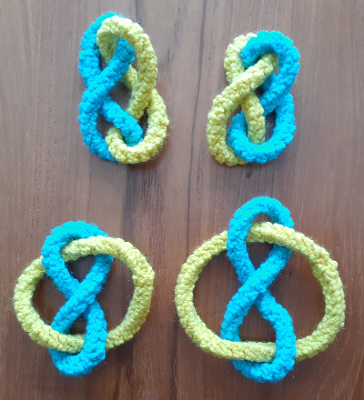Whitehead Links for Ukraine

This is my second crocheting project to help finance our new program, Yulia’s Dream, in honor of Yulia Zdanovska, a young Ukrainian math talent killed in the war.
I made four Whitehead links in the colors of the Ukrainian flag. You can read about my other crocheting project in my previous post: Hyperbolic Surfaces for Ukraine.
Fun trivia about the Whitehead links.
- Why are these links so famous? They are the simplest non-trivial links with the linking number zero.
- What’s the linking number? The linking number is an invariant of a link. If two loops are not linked (they are called an unlink), their linking number is zero. If they are linked, then their linking number is usually not zero. Here the loops are linked, but the linking number is nevertheless zero. Thus, the linking number can’t differentiate this link from an unlink. To explain how to calculate the linking number, I need to explain another simpler invariant: the crossing number.
- What’s the crossing number? The crossing number is the smallest number of crossings when projecting the link on a plane. The top two pictures have 6 crossings, and the bottom two pictures have 5. The top two pictures emphasize the symmetry of the link, and the bottom two pictures have the smallest possible number of crossings for the Whitehead link. So the crossing number of the Whitehead link is 5.
- Can you now explain how to calculate the linking number? One way to calculate the linking number is to choose directions for the blue and yellow loops and select the crossings where the blue is on top. After that, following the chosen direction of the blue loop, at each crossing with the yellow loop, check the latter’s direction. If the direction is from right to left, count it with a plus and, otherwise, with a minus. The total is the linking number. In the case of the Whitehead link, it is zero.
- Is there a more elegant explanation for why the Whitehead link has the linking number zero? Yes. The linking number only looks at the crossings of two different strands and ignores self-crossings. If you look at the two bottom pictures, there is one self-crossing of the blue loop. Now imagine you change the crossing by moving the top blue strand underneath. After such a transformation, the crossing number doesn’t change, but the loops become unlinked. Thus, the linking number of the Whitehead link must be zero.
Tanya Khovanova's Math Blog » Blog Archive » Solomon’s Knot:
[…] However, my favorite link is another link with linking number zero. With the crossing number of 5, it is slightly more complex than Solomon’s link. It is called the Whitehead link, but I already wrote about it in my post Whitehead Links for Ukraine. […]
4 September 2023, 8:43 pmTanya Khovanova's Math Blog » Blog Archive » Solomon’s Knot:
[…] So far, it looks like the linking number grows with the crossing number. Here is where my favorite link, the Whitehead link, comes in. It breaks the previous pattern. It has the crossing number of 5, so it is slightly more complex than Solomon’s link. But its linking number is zero, which is unusual for a linked link. In fact, the Whitehead link is the simplest linked link with the linking number zero, but I already wrote about it in my post Whitehead Links for Ukraine. […]
19 November 2023, 3:27 pm